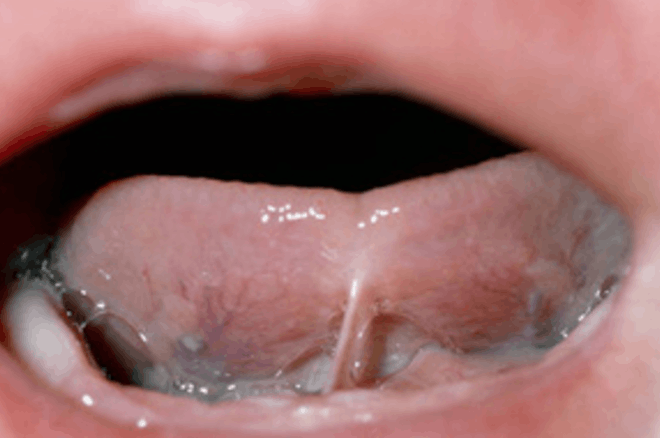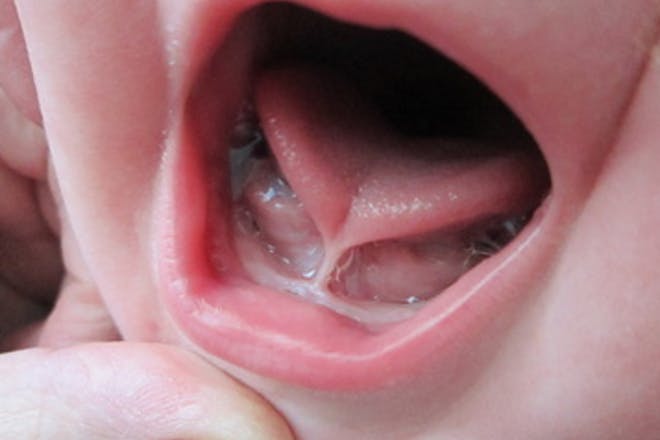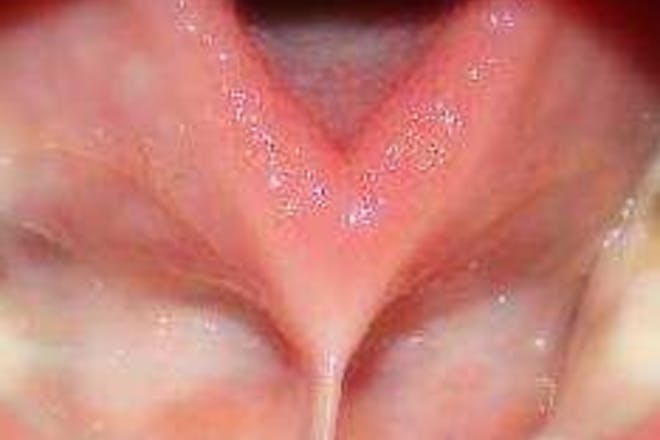What is tongue-tie?

Tongue-tie can affect how your baby feeds from birth. It can also make breastfeeding painful for new mums. Here's the lowdown on how to spot the signs of tongue-tie, and how it can be treated.
This page contains affiliate links, which means we may earn a small amount of money if a reader clicks through and makes a purchase. All our articles and reviews are written independently by the Netmums editorial team.
The NHS estimates that tongue-tie affects around 4-11% of newborn babies. It tends to run in families, and is more common in boys.
Although it's not serious, it often goes undiagnosed, causing problems with feeding and making those early new mum weeks feel even harder than they may already be.
Being aware of tongue-tie can help life with your newborn go more smoothly, especially where feeding is concerned. And although some midwives will spot the issue, it can be easily missed.
FREE NEWBORN NAPPIES
Take Peter Andre's wife Emily, for instance. When she had baby Theo, in 2016, it was Emily’s breastfeeding counsellor – who she was seeing because Theo wouldn’t feed – who spotted the condition.
Emily, who's a junior doctor, confesses that even she didn't realise her baby had tongue-tie.
Here's the facts about tongue-tie, plus what to do if your little one has it.
What is tongue-tie?
Tongue-tie means that the strip of skin connecting a baby's tongue to the floor of the mouth is shorter than usual. This can restrict the movement of the tongue, making it harder for baby to breastfeed.

This can mean your baby may not get enough to eat and may not gain enough weight.
An incorrect latch can also be extremely painful for a new mum, causing nipple damage and even mastitis. As well as the pain factor, this can also affect:
- milk supply
- bonding between mum and baby
- confidence as a new mum
It can also mean giving up breastfeeding before you're ready to.
How will I know if my baby has tongue-tie?
You'll be able to see the tongue-tie when your baby cries and you can see under his tongue. Their tongue looks notched or heart-shaped when they stick it out. It may look a bit like this ...

Your midwife or doctor should spot it in your baby's newborn check and will be able to refer you to a tongue-tie specialist. If you're concerned your baby has a tongue-tie, make sure you mention it to your midwife, doctor or health visitor.
If you're breastfeeding your baby, these could also alert you to a tongue-tie:
- difficulty attaching to the breast or staying attached for a full feed
- feeding for a long time, having a short break, then feeding again
- being unsettled and seeming to be hungry all the time
- not gaining weight as quickly as they should
- making a 'clicking' sound during breastfeeding.
Other signs that may mean your baby has tongue–tie include:
- difficulty lifting their tongue up or moving it from side to side
- difficulty sticking their tongue out
- having a heart-shaped tongue (see more pictures below).
How does tongue-tie affect breastfeeding?
If you're finding breastfeeding painful, it's worth having a look to see if your baby has tongue-tie.
Because a tongue-tie baby can't move his tongue as freely as other babies can, it can make it harder for him to latch on correctly. This can mean the latch is painful and can cause nipple damage, making the whole thing excruciating.
Lots of mums may give up breastfeeding as a result, without even knowing that the pain is caused by tongue-tie and it can be fixed.
How is tongue-tie treated?
Just knowing that your baby has a tongue-tie can make the world of difference if you're struggling with breastfeeding. Now you can do something about it!
As soon as your baby's tongue-tie has been diagnosed, you should be referred to a tongue-tie specialist. He will assess the severity of your baby's tongue-tie and explain the tongue-tie division procedure to help correct it.
This involves snipping the short, tight piece of skin connecting the underside of the tongue to the floor of the mouth. It's a quick, simple and almost painless procedure that usually resolves feeding problems straight away.
The earlier your baby has this the better – although some NHS waiting lists can mean waiting 6-12 weeks for an appointment.
If you want to have the procedure done sooner, it can be carried out privately. Be sure to use a qualified practitioner who has plenty of experience in tongue-tie divisions. Having it done privately can cost upwards of £100.
The Association of Tongue–tie Practitioners (ATP) has a directory of NHS tongue-tie practitioners.
What happens in a tongue-tie division?
If you decide to have your baby's tongue-tie cut, known as a division, here's what you can expect to happen.
Your baby will be in a lying down position, head held securely. This is because the practitioner needs to use sharp, sterile scissors to snip the tongue-tie that's restricting the tongue's movement. Some practitioners use a laser instead of scissors.
Although your baby will probably cry, it isn't a painful procedure. In fact, it's more traumatic for mums than the babies.
There are very few nerve endings in the area around the floor of the mouth, and as you're baby is still so tiny they won't even need an anaesthetic.
The division only takes a few seconds, and you can start feeding your baby immediately afterwards. This will help heal the cut and also calm down your baby.
How long does a tongue-tie division take to heal?
A tongue-tie division will cause some bleeding but this should stop by the time your baby has had a feed. A white or yellow patch may form under the tongue, which takes a few days to heal. It looks worse than it is and won't bother the baby.
Do I have to have my baby's tongue-tie snipped?
If the tongue-tie is affecting feeding, it's a good idea to get it sorted. Although it can feel 'cruel' to have it done, research suggests most babies who have treatment for tongue-tie find breastfeeding easier afterwards.
If it's left untreated, tongue-tie can cause speech and/or eating difficulties in older children.
What does tongue-tie look like?
Tongue-tie can be mild or really severe. Here are some images that will give you an idea of what it can look like ...
Need advice?
Our health visitors and nursery nurses are on line Monday to Friday evenings to answer your queries on feeding, sleep and child health.


If you're worried about tongue-tie, you can get support and advice from other mums in our Coffeehouse forum, below ...



